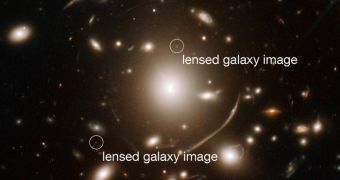The results of a new scientific study suggest that the earliest galaxies ever to develop within the Universe appeared about 200 million years after the Big Bang exploded everything into being.
If this is true, then these findings are in direct violation of established cosmological models, which show that the earliest stars appeared some 300 million years after the Big Bang, and that fully-developed galaxies followed some time after that.
During the new investigation, experts used a variety of telescopes to determine whether a galaxy they were seeing was indeed as distant as it appeared. All the observatories that were used to confirm its existence found it at the same location .
The data suggest the galaxy was formed about 200 million years after the Big Bang, some 13.72 billion years ago. Astronomers say that the new finding pushes back the date of the earliest known galaxy by about 300 million years, Space reports.
With these new information, the entire history of the early Cosmos could be rewritten, the scientists believe. “This challenges theories of how soon galaxies formed and evolved in the first years of the Universe,” explains John Richard.
“It could even help solve the mystery of how the hydrogen fog that filled the early universe was cleared.” the expert adds. Richard is the lead author of a new study detailing the findings, and he is also based at the Center of Astronomical Research of Lyon, in France.
The investigator and his colleagues were able to detect the galaxy by using the advanced capabilities of the Hubble Space Telescope (in visible light, ultraviolet and near-infrared wavelengths) and the Spitzer Space Telescope (in all-infrared wavelengths).
Astronomers used Abell 383 as an enormous gravitational lens. The large galaxy cluster is oftentimes used to boost the intensity of light coming from very distant objects behind it.
“Without this big lens in space, we could not study galaxies this faint with currently available observing facilities. Thanks to nature, we have this great opportunity to see our universe as it was eons ago,” explains University of Arizona expert and study co-author Eiichi Egami.
“Our work confirms some earlier observations that had hinted at the presence of old stars in early galaxies. This suggests that the first galaxies have been around for a lot longer than previously thought,” says University of Cambridge astronomer and study coauthor Dan Stark.
Future space missions will undoubtedly make more sense of these distant objects. Observatories such as the James Webb Space Telescope are being especially constructed to observe extremely far-away objects with a massive redshift.

 14 DAY TRIAL //
14 DAY TRIAL //